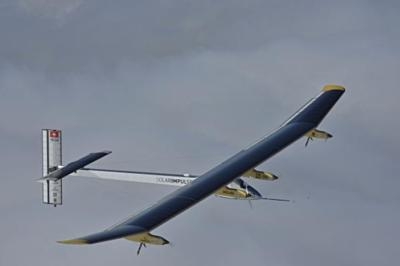Tue, Jun 05, 2012
Departure From Madrid Scheduled Late Monday Night
The Solar Impulse aircraft of Bertrand Piccard and André Borschberg was scheduled to depart Madrid on June 4 at 2330 ESDT (1730 EDT) for the world’s first fully solar-powered flight over the Strait of Gibraltar and landing in Rabat, the capital of Morocco. The Solar Impulse team says the flight is a dress rehearsal as they preparation for their world tour in 2014, which includes at least one stopover in the U.S.

The first leg of the trip was piloted by André Borschberg from Switzerland to Spain. The flying duties will now be handed off to Bertrand Piccard in their mission to complete the challenge to reach Morocco ... flying for over 1,550 miles without a drop of fuel.
The flight plan called for the aircraft to take off Monday, June 4th from the Madrid-Barajas airport (Spain)and climb to an altitude of 12,000 feet heading to of Seville. The HB-SIA will then cross the Gibraltar strait over the Mediterranean at an altitude of 28,000 feet around 1200 (ESDT) entering Moroccan airspace via Tangier en route to Rabat, the capitol city of Morocco. The prototype is expected to land in Rabat-Salé international airport on Tuesday June 5th at about 1800 ESDT, or 1300 EDT, avoiding the peak of international air traffic.
Under the high patronage of King Mohammed VI and upon invitation of the Moroccan Agency for Solar Energy (MASEN), the Solar Impulse team will participate in MASEN’s commencement of construction activities in the Ouarzazate region of what will be the world’s largest thermo-solar power plant. Of a capacity of 160 MW, the plant is part of Morocco’s energy plan whose goal is to build, by 2020, five solar parks with the capacity of 2000 megawatts, reducing CO2 emission of 3,7 million tons. Solar Impulse supports this pioneering project which is in line with its own message and its philosophy of renewable energies.
Although the flight has been confirmed, the Flight Director may still decide to postpone it or alter the route up to a short time before takeoff. The flight can be tracked live via a LiveStream video running throughout the flight with images and sound from the pilot in action, take-off, landing and interaction with the Mission Control Center. Aside a virtual cockpit with all the essentials (ground speed, heading, altitude, solar generator power, etc.) and a tracking map will be available. (Image © Solar Impulse | Jean Revillard)
More News
Terminal Radar Service Area Airspace surrounding designated airports wherein ATC provides radar vectoring, sequencing, and separation on a full-time basis for all IFR and participa>[...]
Very High Frequency (VHF) The frequency band between 30 and 300 MHz. Portions of this band, 108 to 118 MHz, are used for certain NAVAIDs; 118 to 136 MHz are used for civil air/grou>[...]
“From approximately November 2021 through January 2022, Britton-Harr, acting on behalf of AeroVanti, entered into lease-purchase agreements for five Piaggio-manufactured airc>[...]
Also: Virtual FLRAA Prototype, IFR-Capable Autonomous A/C, NS-32 Crew, Golden Dome Missile Defense Bombardier announced that the first production Global 8000 successfully completed>[...]
Aero Linx: The 1-26 Association (Schweizer) The Association’s goal is to foster the helpfulness, the camaraderie, and the opportunity for head-to-head competition that is fou>[...]
 ANN's Daily Aero-Term (05.29.25): Terminal Radar Service Area
ANN's Daily Aero-Term (05.29.25): Terminal Radar Service Area ANN's Daily Aero-Term (05.30.25): Very High Frequency (VHF)
ANN's Daily Aero-Term (05.30.25): Very High Frequency (VHF) Aero-News: Quote of the Day (05.30.25)
Aero-News: Quote of the Day (05.30.25) Airborne 05.23.25: Global 8000, Qatar B747 Accepted, Aviation Merit Badge
Airborne 05.23.25: Global 8000, Qatar B747 Accepted, Aviation Merit Badge ANN's Daily Aero-Linx (05.30.25)
ANN's Daily Aero-Linx (05.30.25)



